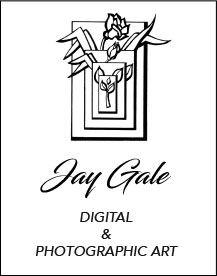Don’t Read This Bullshit
/0 Comments/in Uncategorized /by Jay GaleWell, I had to do something to get your attention!! After all, a study by Microsoft indicates that the average attention span of an American is 8 seconds (nine seconds for goldfish). We are now at the end of our 8 seconds, so I hope I have interested you enough to read on.
It is the same problem I have as an artist. If I do not grab your attention and find a way to hold it within 8 seconds I have failed. So how do I do that? I do it with large format digital prints with bright complimentary colors or stark black and white.
But let’s say I grab your attention in the first second or two; I still need to find a way to do hold your attention. I do that by creating a visual puzzle using lines, shapes, colors, or elements that your mind doesn’t immediately recognize. I call it the What The Hell Is That Effect? It is a built in ambiguity that allows the viewer to insert his or her own unique creative abilities into the artistic process.
Now, I know that I have gone way beyond my allotted 8 seconds, but if you have any interest in the psychology of my art, read on (if not read on anyway, it’s interesting).
Have you ever just leaned back on a beautiful starlit night and gazed at the amazing beauty of our solar system. While you’re stargazing, it is hard not to pick out some of the main groupings and constellations of stars. I always look first for the big dipper, because it is the easiest to find, but if you know your cosmos well, try and pick out Taurus, the bull, or even better, try and connect the dots (stars) and come up with a shape of your own.
Now think!! How are you able to do that do that? There are no water dippers in the sky/ there are no bulls – just some bright dots on a dark background. How did you create objects out of that amorphous group of dots?
What you have done is fulfilled two important psychological principles; filling in the gestalt and projecting your own psyche into a vague image. And I bet you thought you were just looking at the sky.
Those are the same two principles I use to create my artistic puzzle. When you are viewing my digital art, I count on you trying to make sense out of the ambiguity I present to you, just as you did with the constellations in the sky (that is called filling in the gestalt). Then, as you view this still ambiguous piece of art you interpret it based on your own personal conscious and unconscious needs (psychologists call this the projective hypothesis). And likewise every other viewer is free to interpret it based on his or her unique needs. I told you it would be interesting.
That is why I refer to my digital art as Projective Expressionism. Expressionism is a 20th century art movement in which the artist seeks to represent his own personal emotional experience rather than depicting the external world. My art changes that around. I use ambiguous depictions of the external world and have the viewer project his or her own personal needs and experiences. Thus, my goal is to create a synthesis in which my personal vision and your creativity result in a collaborative artistic experience.
Anyway, if you made it this far, I held your attention. Enjoy my art. I think it too will hold your attention.
Where Was This Picture Taken?
/0 Comments/in Uncategorized /by Jay GaleFrom the time that George Eastman introduced the inexpensive Kodak Brownie camera in 1900 the world has accepted the photograph as a way of visually documenting beauty and ugliness of all kinds. Especially in the twenty first century, when virtually everyone has become a photographer through the use of cell phone cameras and social media, photography has in many ways replaced the written word as a way of recording history- personal history, family history, and the history of mankind.
Even as I write this blog is difficult to do without photographs as a way of demonstrating my point. However, it is this very lengthy history of photography as a documenter of reality that has interfered with the photograph becoming accepted as an art form.
When people see some of my Gestalt Visions digital art usually the first question is “where was that taken?” Their initial expectation is that this piece of art must be a documentation of a place, and if they can just know where it was taken it will make the photograph more meaningful to them.
I thank you for that compliment to my work, for that is partially the intended response. I want you to look at my art, not just glance at it. Your mind, working on a logical level is trying to fill in the Gestalt and make sense of it. Your eyes stare at the colors and the shapes and your mind tries to put a name to it. But if you look it it long enough hopefully your mind shifts from the where, who, and what level to just enjoying it as a piece of art – a happening. So please excuse me if I don’t answer your question. It is not that I am being rude or a temperamental artist-I just don’t want to ruin the experience for you.
When you look at the Mona Lisa, is it important to know what city has Da Vinci painted in the background? Not only is it not important, but if you turn the visual experience into an intellectual exercise you miss the beauty of the painting.
Photographic art is not about, where, who, and what. Snapshots are about where, who and what. Photographic art does not document history – it exists in a separate, beautiful world. The beauty is not in the where, the who or the what, it is in the mind of the artist and the eyes of the viewer.
That is where my photos were taken. In the creative recesses of my mind.



